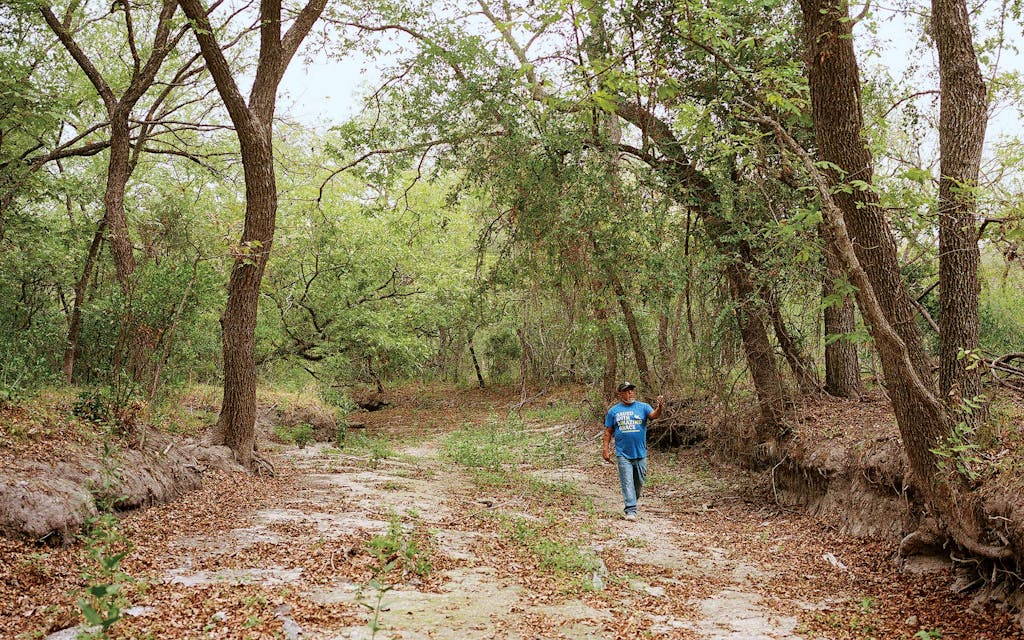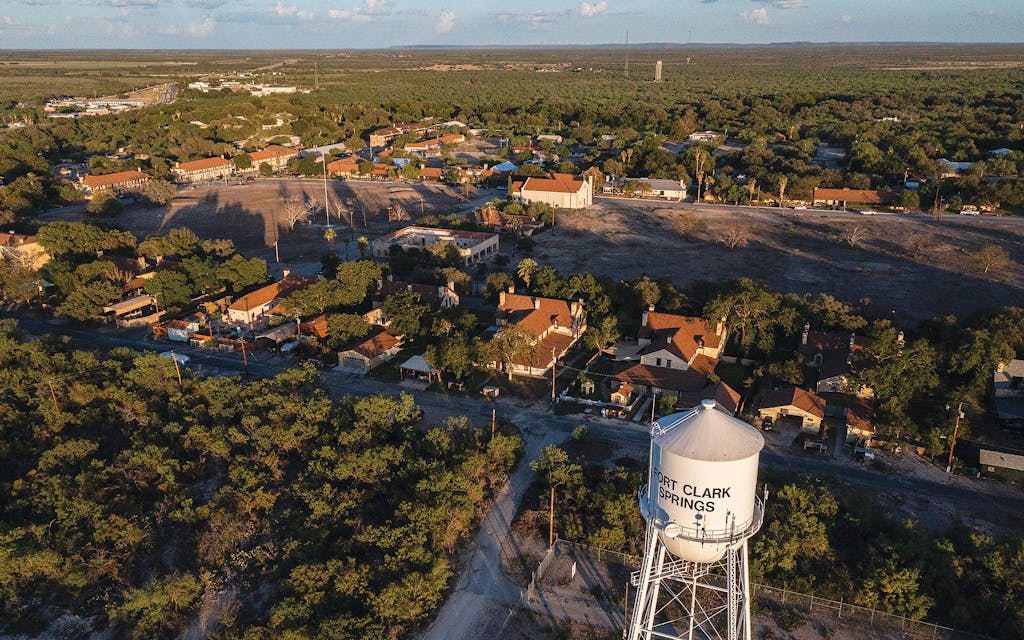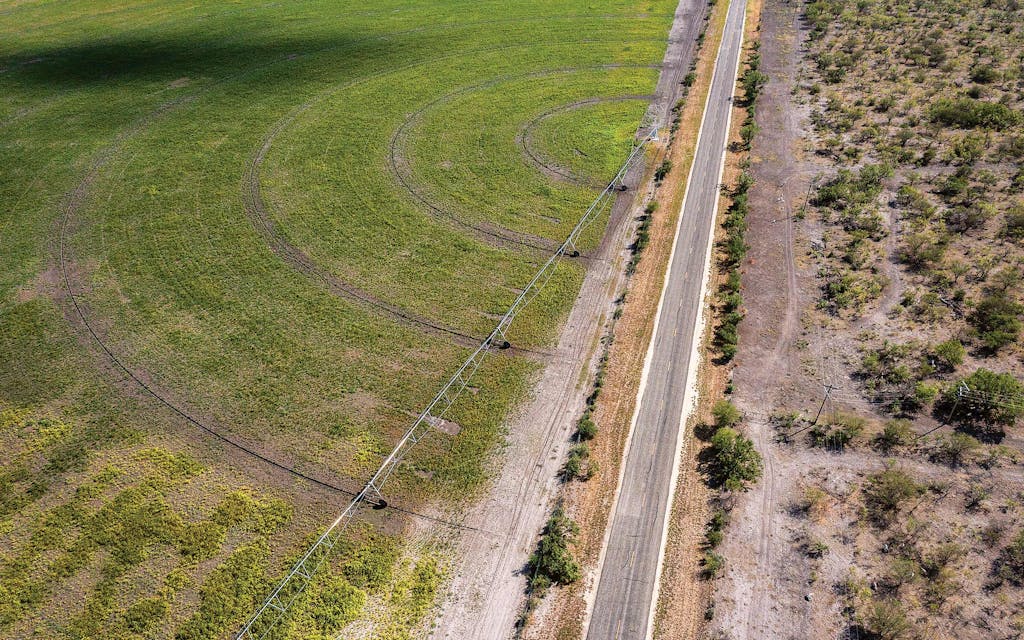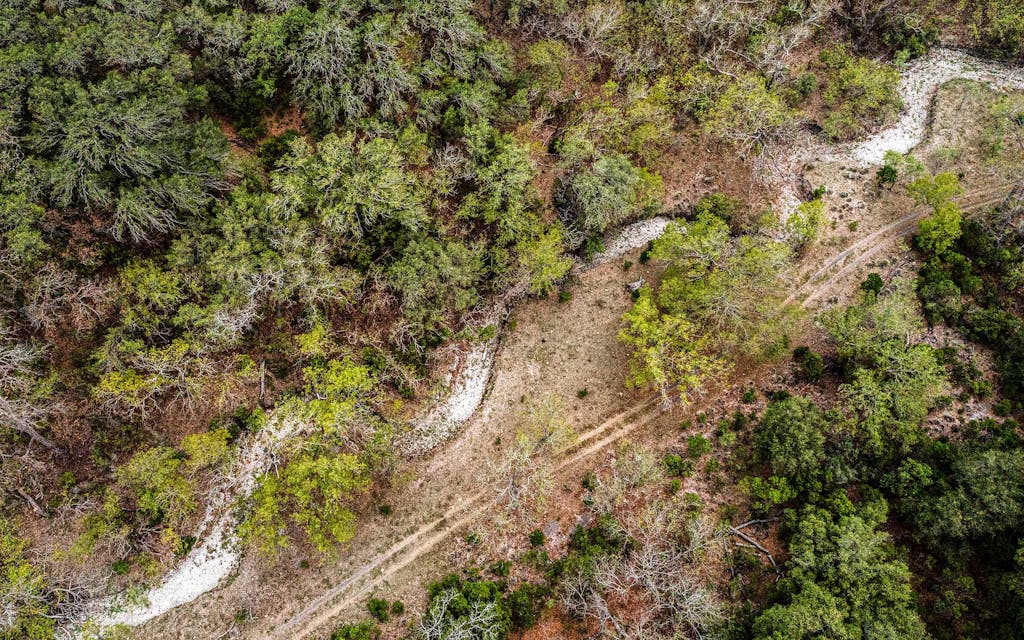April 8 is significant to Travis Huey for two reasons.
It’s the date when, in 2024, the narrow path of a total solar eclipse will pass over Brackettville, the small southwest Texas town where he lives. Huey owns the local newspaper, the Kinney County Post, and he’s the president of the association that runs Fort Clark Springs, a private resort and historic site in Brackettville that has struggled to attract visitors in recent years. Huey has big plans for the fort that include drawing 5,000 visitors to the four-minute, eighteen-second eclipse.
But April 8, 2022, complicated his plans. That’s the day when Las Moras Springs, which typically pumps out 12 to 14 million gallons of cool, clear water a day—enough to fill two dozen Olympic size swimming pools—stopped flowing into the fort’s swimming pool, the third-largest spring-fed pool in the state and Fort Clark’s main attraction. With the pool empty and the springs quiet, the trickle of tourists that sustains the struggling fort all but dried up too. Planning for April 8, 2024, ground to a halt. “I can’t put five thousand people on this fort and not have our main amenity,” Huey said as he showed me around the springs on a scorching July afternoon. “That would be a PR nightmare.”
There wasn’t a soul outside at the fort, where the effects of drought were increasingly apparent. In a copse of oaks, a skittish whitetail deer peered over at the springs as if confused about the absence of water. Las Moras Springs, the ninth largest in the state, normally fills a large, rock-lined basin that then feeds the swimming pool, as well as a bypass channel that supplies water to Las Moras Creek, which then runs 29 miles to the Rio Grande. Before it dried up, the basin was so thick with aquatic vegetation that Huey wasn’t sure of its depth. Now the plants were dead, dried into a ghostly white powder.
Despite the heat, Huey, a svelte 36-year-old oil and gas industry consultant who grew up in Cibolo, just outside San Antonio, and attended Texas A&M University, was dressed in a fashionable black V-neck. He has a serious manner and looks a little out of place in dusty Kinney County (population 3,129), where youngsters tend to leave and never return. But he has roots here. His grandparents moved into a house on the fort in the seventies, and Huey visited frequently as a kid. He remembers swimming in the deep end of the pool, paddling in place against the push of the spring flow. “I got the bug early,” he said.


When COVID-19 hit, in 2020, Huey grew restless living in San Antonio. “I was like, ‘You know, I might as well go where they know how to work with things that are shut down constantly,’ which is Brackettville. Everything was pretty normal out here.” He bought a house at the fort, along with the local newspaper. Pretty soon, he plunged into the operations of Fort Clark Springs—a 2,700-acre community that somewhat awkwardly functions as part historic site, part housing development, and part resort.
The generous springs long served as a watering and camping ground for Native Americans, including Apache and Comanche who used it as a way station on forays into Mexico. The waters held similar attractions for the U.S. Army, which established Fort Clark in 1852 as a frontier military outpost along the San Antonio–El Paso Road, an important trade route that facilitated westward expansion into Indian Territory and guarded against a restive Mexico to the south. Black Seminole scouts served at the fort from 1872 until 1914, and one of the last horse-mounted cavalry divisions trained here during World War II. After the war, the fort was deactivated, sold to Brown & Root, the Texas construction behemoth, and later converted into a guest ranch. Today its sprawling grounds—all run by a homeowners association—include a golf course, almost nine hundred homes, a motel, nature trails, an airport, an RV park, and more than thirty historic buildings, some of which date back to the fort’s founding.
Huey said he discovered that years of mismanagement and infighting within the HOA had left the enterprise with battered finances and no real business plan. (The only other guests at the motel the night I stayed there were Department of Public Safety officers serving out their border deployment.) Last year, Huey was elected to the board on a promise to run Fort Clark Springs more like a business. He was hard at work on various renovation projects—a motel remodel and a revamp of the RV park with an eye toward April 8, 2024, as a big coming-out party—when the pool went dry.

As Huey tells it, the water in the swimming pool had been lowered for cleaning, but he was surprised to find that it hadn’t filled back up. More surprising still: the water level in the spring basin would drop a few inches and then, just hours later, rise a couple of inches. To Huey and others at the fort, it looked like the effects of a pump turning on and off, pulling water out of the underground aquifer that feeds the spring. “We watched the spring drop four inches in less than two hours,” said Alan Peterson, the general manager of the fort. “And that didn’t happen because of dehydration and evaporation from drought; that happened because water was being pumped out of that aquifer.”
If so, who was doing the pumping? Peterson pointed to farms and ranches in Kinney County that irrigate with water from the aquifer. He paused and then laughed. “Now, I’ll get shot if you say that I said that.”
Huey too suspected that pumping, whether from irrigated agriculture or from wells that supply the fort and the city of Brackettville, was conspiring with a worsening drought to put the springs—and by extension Fort Clark and all of Kinney County—in peril. No springs, no pool, no tourists, no economy. “The fort is going to be the economic driver for the county going forward. There’s no more sheepshearing here. There’s very little ranching and not enough to support an entire county. This is not a place to grow crops,” Huey said. “This is going to be a tourist location. They’re going to come for the Indigenous artifact hunting. They’re going to come for the birding, and they’re going to come for the creek and for hunting. That’s what we got. That’s a pretty good set of stuff to work with. But . . . the only way we’re going to get there is if we have water.”


Huey and his allies—residents of the fort as well as some major Kinney County landowners—worry that Fort Clark and Las Moras could face the same fate as Fort Stockton and Comanche Springs, 215 miles northwest of Brackettville. Comanche Springs was once one of the most productive oases in West Texas, for millennia a refuge for Native Americans, Spanish explorers, and eventually the U.S. Army, which established a military camp near the springs in 1859, part of a string of frontier fortifications that included Fort Clark. Later, farmers turned to the springs to water their crops, and by the 1930s the bustling desert town was celebrating its liquid abundance with an annual water carnival.
But Comanche Springs dried up in the 1950s, after irrigators with newfangled motorized pumps began gulping from the Edwards-Trinity Aquifer west of town. The local water district sued on behalf of farmers who irrigated their crops with the surplus of the spring, but the defendants, led by the father of future gubernatorial candidate Clayton Williams Jr., persuaded the court to let them keep pumping. Today the springs are a wet-weather phenomenon, gurgling a bit in the winter before a long hot-season quiescence. The town has never fully recovered, economically or spiritually. William Conoly, whose family has ranched on Las Moras Creek for the past 120 years, said the parallels are clear. “It’s the same story,” he said. “They put a bunch of irrigation pumps right next to the spring.”
Across much of Texas, the latest drought, which began last winter and rapidly intensified this summer amid record-breaking heat, sapped aquifers and the wells, springs, and streams that rely on them. But it’s not just lack of rainfall and extreme heat—ever more common in a warming climate—that are taxing Texas’s groundwater. Aquifers are under increasing stress from a boom in population, irrigated agriculture, and water-intensive fracking. And the state is struggling to keep up. A patchwork of local groundwater districts are tasked with figuring out how to manage aquifers. By and large, they’re planning to deplete their groundwater over time rather than manage it sustainably. “We’re reaching the limit of sustainable groundwater pumping, which means we’re fixing to cross the threshold of mining these aquifers,” said Robert Mace, a former top administrator at the Texas Water Development Board and now the executive director of the Meadows Center for Water and the Environment at Texas State University.
Aquifer mining is already happening in some places. In Hays County, a rapidly suburbanizing chunk of the Hill Country between Austin and San Antonio, the once-perennial artesian spring Jacob’s Well, which relies on the Trinity Aquifer, stopped flowing this summer for only the fourth time in recorded history. Many spring-fed rivers transformed from flowing streams into disconnected pools of stagnant water. And many private wells were, as locals put it, “sucking air.” By the time this story went to press, the drought seemed to be receding the way so many dry spells in Texas do: with biblical deluges and flash flooding. After a few well-placed rainstorms soaked parts of Kinney County, Las Moras Springs started to trickle again, just enough to fill the swimming pool for now. But a temporary respite, as welcome as it may be, won’t resolve the state’s simmering conflicts over water.

Kinney County is no stranger to water fights. It’s a small place, population-wise, dominated by a handful of non-Hispanic white, landowning families that have long taken turns running local government. Everyone here remembers, not too fondly, the ugliness of the late 1990s and early 2000s, when neighbor was divided against neighbor over proposals to sell groundwater from the Edwards-Trinity Aquifer to thirsty cities such as Eagle Pass and San Antonio. Both north and west of Brackettville are rich reserves of Edwards-Trinity groundwater, abundant enough to supply numerous artesian wells that farmers depend on to irrigate crops, along with a water table high enough to nourish the few flowing creeks in the area. Some landowners had teamed up with for-profit water marketers, believing the county’s groundwater plentiful enough to pipe south and east without harming the wells, streams, and springs, including Las Moras, that draw from the same aquifer.
Kinney County never had a farming economy on the scale of crop-rich Uvalde and Medina Counties to the east, and what little remained was a fraction of what it had been during the area’s heyday. Why not put the water to more profitable use? Other landowners saw things quite differently. They accused their neighbors of joining with speculators to recklessly deplete one of the county’s few resources.
What made a bonanza plausible was a legal concept that dates to ancient Rome, fifteen centuries ago, and has survived in Texas to this day: the rule of capture, known informally as the rule of the biggest pump. First articulated in a 1904 decision by the Texas Supreme Court, the rule holds that landowners have a right to the water beneath their land and can, with few exceptions, pump as much as they’d like—consequences to neighbors, the environment, or future generations be damned. Only nine other states rely on the rule of capture, and none of them are drought-prone Western ones. Comanche Springs died at the hands of the regulation.

To provide some check on the greed that the rule encourages, Texas allows communities to form local groundwater conservation districts—regulatory bodies overseen by elected boards. Today, 98 such districts operate across the state, including the Kinney County Groundwater Conservation District, which was overwhelmingly approved by local voters in 2002, during the controversy over whether to export water to thirsty cities. The district’s board, dominated by export skeptics, began writing rules and deciding how much pumping to allow. What resulted was a mess. The groundwater district ended up allocating far less water for irrigation than many farmers expected to receive, and even less than the district’s hydrologist had recommended, in most cases. The Legislature threatened to dissolve the district and bring the county under the control of the San Antonio–based Edwards Aquifer Authority. Angry landowners sued the district, and litigation over the water permits wasn’t fully settled until last year.
Those who wanted to secure rights to pump a lot of water ultimately prevailed in court. Now landowners in Kinney County have rights to some 74,000 acre-feet—enough to cover the city of Austin in four inches of water, and a figure that’s based on claims made about how much water had been used in the past, some of which go back decades. (According to Conoly, some of the claims were “inaccurate” and others were “outright lies.”) Nonetheless, the export schemes fizzled, largely because of business plans that didn’t pencil out and potential customers who lost interest. Today many combatants regard the episode as an unfortunate chapter in community history.
In the months after Las Moras dried up, Huey and his allies started asking questions about the groundwater district’s management of the aquifer. They quickly became convinced that some irrigators were sapping the county’s groundwater resources at an unsustainable rate. Huey and company were disturbed that the district doesn’t require permit holders to curtail pumping during times of drought, which is common practice in some water districts.
At a July 14 meeting of the district leaders in their cramped offices next to the county courthouse, the board members and their hired engineer and hydrologist seemed eager to convey a message: The desiccation of the springs was largely an act of God. The drought, not pumping, was primarily to blame for the sad situation at Las Moras. Before the meeting, board president John Paul Schuster, a bulky real-estate agent and former banker who wears a knife on his belt, invited anyone who didn’t want to pray to go outside. He then asked God “to bless this land with a little nourishing rain.” When a Kinney County resident asked what the board planned to do to address the springs, Schuster shot back, “Pray for rain.” Rainfall had been low for the past few years, and 2022 had seen only a few inches total in a region that averages 24 inches a year. The district’s contract engineer chimed in, “The springs are driven by rainfall, not anything else.” (The hydrologist later offered a subtle corrective: if pumping is zeroed out, “they’ll come up a little bit.”)
Why, then, had the district set—and reaffirmed—a goal of maintaining spring flows at Las Moras? The short answer: the goal was established in 2010, before there was a chance to carefully study the aquifer. Now, more than a decade into a data-gathering effort, there was a growing understanding that rainfall, not pumping, was the major player in the health of the springs. Though permit holders have the right to pump 74,000 acre-feet, actual pumping has totaled only about 5,000 acre-feet per year in recent years, according to the district. That’s far less than what it believes was pumped decades ago, when area farmers used flood irrigation to grow vegetables, instead of more efficient center-pivot irrigation.
The meeting was cordial, but Schuster, who is the Republican nominee for county judge, ended the day with a warning to critics: “If you’re gonna try to rip me in public, be ready, all right? I don’t take free ass chewings, and I’m sitting right here in this chair a lot lately—for free.” Gentler now: “Our county is not fixing to fall off in a sinkhole or dry up. This too shall pass. God is not gonna deal us anything we can’t handle.”

Huey and others on his side aren’t so sure. They acknowledge that drought is a big factor in spring flow but contend that pumping also plays a major part. And they were put off by what they viewed as a dismissive tone from board members. “The board seems to have the view that pumping has no effect on the springs,” said Conoly. “And some board members feel like, even if it did, they wouldn’t curtail pumping. We can’t have that. The whole point of the board is to regulate production to protect other people’s wells as well as the spring.”
Even basic facts, such as how many times Las Moras has dried up in the past, are hard to pin down. Accurate record-keeping and consistent data weren’t available until 2014, but according to records maintained by the U.S. Geologic Survey, the spring ceased flowing for the first time in recorded history in 1964, not long after a bounty of water was discovered in the Pinto Valley. (Headline from the San Antonio Express: “Irrigation Blamed for Drop in Flow of Famous Springs.”) It went to zero again in at least five subsequent years, including 2022. The district’s hydrologist claims these periodic cessations are evidence that rainfall has a more direct link to spring flow. From a longer view, however, they may instead suggest that the springs kept flowing through bad droughts, such as the one in the fifties, before the advent of commercial agriculture.
Conoly, who worked as a reservoir and production engineer in the oil and gas industry for seven years, used the district’s own data and modeling to statistically explore the relationship between pumping and spring flow. He said he found that on average, for every cubic foot of water removed by pumping, spring flow is reduced by nine-tenths of a cubic foot. “This is a bit of a smoking gun in the world of statistics and shows a direct correlation between pumping and spring flow,” he said. (The district’s hydrologist said Conoly’s analysis merits further evaluation but may overestimate irrigated acreage.)
Huey argues that the district has been mismanaged and negligent in carrying out its basic duties. Not much has changed, he said, since 2010, when the state auditor’s office found that the district had failed to fix 31 out of 32 deficiencies in its finances and management, including such basics as securing a financial audit, preparing an annual report, and managing water usage by permittees. He points out that the district has never created a drought contingency plan or implemented rules to reduce pumping. (Genell Hobbs, the general manager for the district, said “the plan is to commence development” on a drought plan and “other minor items” sometime this year.)
As in many Texas districts, permit holders self-report their usage at the end of the year. But many of the reports I examined were incomplete or contained discrepancies in the amount of pumping. Some were stamped as “received” in July 2022, more than a year and a half after they were due, suggesting that the reports may have been submitted after Texas Monthly filed an open records request.
One permit holder, Darlene Shahan, told me that years went by before she realized she hadn’t filed a pump report or paid for a renewal. “They should shut me down if I don’t renew my permit,” she said. She should know—she and her husband, Tully Shahan, the current Kinney County judge, were instrumental in fighting the water-marketing schemes of yesteryear, and Darlene served as the district’s first general manager.
In 2010 the district’s board voted to adopt a long-term goal of maintaining an annual average flow at Las Moras of about 24 cubic feet per second, enough to fill an Olympic-size swimming pool 23 times a day. But according to data I reviewed, the average daily flow has been below 24 cubic feet per second for three of the past four years. Greg Ellis, a veteran Texas water attorney who serves as the district’s legal counsel, said he didn’t know if the district was meeting its goals. Much depended on figuring out the precise effects of pumping on the springs. But, he allowed, if the goal isn’t being met, then that’s “obviously problematic in that it makes it look like the district is not doing its job.”
Conoly said he believes the board is making moves to abandon healthy spring flow as a planning goal and instead do what many other Texas districts do—assume a future in which the aquifer is depleted.

Kinney County sits at the edge of the Chihuahuan Desert. Drive another thirty minutes west on U.S. 90, and you’re in the land of ocotillo and no trees. Drive the six and a half hours from Del Rio to El Paso across Texas’s own Empty Quarter, and the biggest town you’ll encounter is Alpine, population six thousand. “I think that Brackettville is as good as it is because of the spring,” Conoly said. “People enjoy living there. It’s a pretty town—it’s got nice restaurants, a good little store.” Without the water, he said, it would “turn into a dust bowl.”
The other side cherishes the springs too. One farmer I spoke to said he learned how to swim at the pool at Fort Clark and considers it the gem of the community. Schuster said his goal is to keep Kinney County a place that young people want to come back to. Huey and Conoly are exploring their options. One is to run a slate of conservation-minded candidates for the district board. Another is the “nuclear option”—petitioning the Texas Commission on Environmental Quality (TCEQ) to dissolve the groundwater district. But that could open the door to what the district was created to avoid: a race by landowners to suck the aquifer dry, under the rule of capture.
Groundwater districts are often underfunded, understaffed, and subject to competing demands. Their jurisdictions correspond to political boundaries—county lines, mostly—rather than to the irregular shapes of aquifers. And even if there is the will to sustainably manage an aquifer, districts often struggle to impose limits on groundwater extraction in a state that prizes limitless growth. The overwhelming majority of local groundwater districts are planning for declines in aquifers they manage, according to a 2021 report by the Meadows Center. With few restraints, Texas is already pumping groundwater at almost twice the sustainable rate.
The Kinney County Groundwater Conservation District is one of the few that states as a goal the maintenance of spring flows. But does that matter if the regulators claim to believe that regulation has little effect on the springs? Conoly argues that the district shows how the state’s system of local groundwater management has become “corrupted.” In rural areas, it’s all too easy for “anti-regulation-minded interests” to take over groundwater districts and thwart regulations that would limit pumping.

“We need more oversight by the state that mandates certain minimum protections be enacted by water districts, preventing aggressive overpumping and using spring and stream flow as benchmarks for healthy pumping levels,” Conoly said. Without that, “a minority interest of pumpers will continue to drill wells near springs in order to capture the water that would otherwise flow to those springs and profit at the cost of dried springs, creeks, and rivers across the state, decimating the communities around them.”
To escape the heat at Fort Clark one day in July, Huey and I ducked into a rough-hewn stone building that once served as officers’ quarters and is now a private residence owned by a friend of Huey’s. He showed me some of the brochures that were used to lure Texans to the fort in its glory days. One pamphlet, written in the unironic and hyperbolic advertising style of the fifties, invoked the “Indian legend” of Las Moras: “The Seminole believed when one crossed these waters he was cleansed of his sins.” Huey isn’t attempting anything as grandiose as a ritual cleansing. But he would like to at least keep the springs in Fort Clark Springs.
This article originally appeared in the October 2022 issue of Texas Monthly with the headline “Gone With the Flow.” Subscribe today.
- More About:
- Politics & Policy
- Water
- Longreads
- Drought








